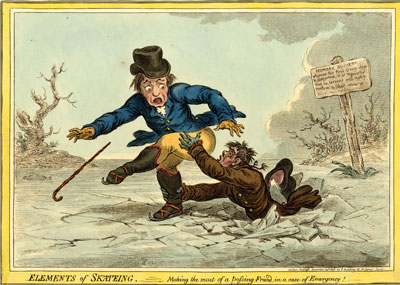Elements of Skateing:
Making the Most of a Passing Friend, In a Case of Emergency!
This is the fourth of a four-print series, Elements of Skateing, strategically scheduled for sale in late November as winter arrived in Britain, reviving the interest in (and possibility of) ice skating on lakes, ponds, and streams. If you haven't already done so, you may want to look at my Introduction to the series which provides some general background about ice skating and its portrayal in paintings, prints, and drawings before Gillray.

Making the Most of a Passing Friend, In a Case of Emergency!
[November 24, 1805]
© Trustees of the British Museum
Because of the generally mild and inconsistent weather, ice skating in Britain was always a risk. Unlike in Holland where freezing temperatures came early and often and the thickness and solidity of the winter ice could be generally depended upon, British skaters had to be especially wary of skating on thin ice. And every winter season brought incidents, reported in various newspapers, of skaters drowning, or nearly drowning.
Here's an example from the London Star of December 18, 1805.
About three o'clock yesterday a considerable number of skaters ventured on the Serpentine River, many of whom narrowly escaped the fate to which their temerity had exposed them. Three persons, however, in skating, broke the ice and fell in, who, with the utmost difficulty extricated themselves from their perilous situation. Although thousands, on both sides, wished to afford every relief to the first who fell in. . . yet their commiseration, and their exertions with knotted pocket handkerchiefs, &c. were unavailing at so great a distance from the banks. After several attempts to support himself on the ice which repeatedly broke under him, he succeeded, at length, when hopes had flagged, and his strength had almost failed him, in scrambling on the surface; but it broke down in two other places before he reached the shore, which he had at last gained with the loss of his hat by the first fall. Ropes arrived, as usual, when they could be of no service.
As a result of incidents like these, according to the Morning Chronicle for January 1, 1805,
His Majesty, in 1798, graciously granted to the Humane Society a plot of ground, near the Serpentine River, for a receiving house, which is furnished with a warm bath, couchette, dispensary and electrical apparatus. — Men are daily employed round the River, with a badge on their arms, inscribed Humane Society, in order to caution all persons from the dangerous parts, and have at hand a preservative ladder. Many have been fortunately rescued from under the ice, and restored to their friends.
A temporary receiving house can be seen in the background of the Rowlandson print Cold Broth & Calamity (1792) shown in my Introduction.
Signs, like the one in this Gillray print, were likely part of the Humane Society effort when representatives could not be present: "Humane Society - Whereas this Pond is very deep & dangerous, it is requested that no persons will rashly venture to Skait upon it." .
Enthusiastic skaters in the 18th century, however, were no more likely to be deterred by signs warning of danger than they are today. So whenever skating prints and drawings were produced, they usually included at least one or more skaters falling through the ice into the water as in the man in the foreground of Rowlandson's Skating on the Serpentine in Hyde Park. Gillray's, however, is virtually unique in depicting a concentrated struggle for survival between two skaters, one fallen through, the other not.
Sources and Reading
- Commentary from the British Museum on Elements of Skateing: Making the Most of a Passing Friend, In a Case of Emergency!.
- Rachel Knowles, "Ice Skating in Regency London," Regency History
- "Ice skating," Wikipedia
- "Ice Skating," Encyclopedia Britannica
- Robert Jones, A Treatise on Skating
- "Robert Jones (artilleryman)," Wikipedia
- "Royal Humane Society," Wikipedia
- Thomas Wright and R.H. Evans, Historical and Descriptive Account of the Caricatures of James Gillray #540.
- Thomas Wright and Joseph Grego, The Works of James Gillray, the Caricaturist; With the History of His Life and Times, p. 326.
Comments & Corrections
NOTE: Comments and/or corrections are always appreciated. To make that easier, I have included a form below that you can use. I promise never to share any of the info provided without your express permission.